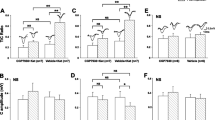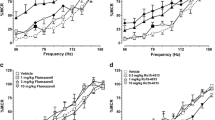Abstract
Rationale
Although convergent evidence exists for a role of glutamate in the regulation of anxiety, the involvement of specific glutamate receptor subtypes has yet to be defined.
Objective
To evaluate the potential for blockade of alpha-amino-3-hydroxy-5-methyl-4-isoxazolepropionate (AMPA)/kainate receptors to produce anxioltyic-like effects with the AMPA/GLUK5 (kainate) antagonist (3S,4aR,6R,8aR)-6-[2-(1(2)H-tetrazole-5yl)ethyl]decahydroisoquinoline-3carboxylic acid (LY293558)
Materials and methods
Punished responding of rats was used to determine the efficacy of LY293558. Other in vivo and in vitro studies further characterized the specificity of LY293558 for AMPA/kainate receptors.
Results
LY293558 had a rank order of potency of GLUK5 ≥ GLUK5/6 ≈ GLUA2i ≈ GLUK2/5 ≈ GLUA1i ≈ GLUA2o ≈ GLUA3i ≈ GLUA1o ≥ GLUA3o ≥ GLUA4i ≈ GLUA4o and >100 μM affinity for rat cortical GABAA receptors. Comparison of the blockade of AMPA- vs N-methyl-d-aspartate (NMDA)-induced inward currents demonstrated that LY293558 was five-fold more potent as an antagonist at AMPA vs NMDA receptors in vitro. In keeping with the low affinity of LY293558 for NMDA receptors, LY293558 was not effective in preventing NMDA-induced seizures in mice. LY293558 increased punished responding, a preclinical predictor of anxiolytic efficacy, at a dose that decreased unpunished responding (10 mg/kg, i.p.). Chlordiazepoxide produced comparable increases in both punished and unpunished responding. The NMDA antagonist dizocilpine [(+)-MK-801] also increased both punished and unpunished responding.
Conclusions
These data along with those in the literature suggest that AMPA and/or kainate receptor blockade may be an important component to producing anxiolytic-like effects and may therefore be a target for compounds with efficacy in the therapeutic treatment of anxiety disorders.


Similar content being viewed by others
References
Alt A, Weiss B, Ogden AM, Knauss JL, Oler J, Ho K, Large TH, Bleakman D (2004) Pharmacological characterization of glutamatergic agonists and antagonists at recombinant human homomeric and heteromeric kainate receptors in vitro. Neuropharmacology 46:793–806
Bainbridge JG (1968) The effect of psychotropic drugs on food reinforced behavior and on food consumption. Psychopharmacologia 12:204–213
Barrett JE, Witkin JM (1991) Buspirone in animal models of anxiety. In: Tunnicliff G, Eison AS Taylor DP (eds) Buspirone: mechanisms and clinical aspects. Academic, New York, pp 37–79
Benvenga MJ, Ornstein PL, Leander JD (1995) Schedule-controlled behavioral effects of the selective 2-amino-3-(5-methyl-3-hydroxyisoxazol-4-yl)propanoic acid antagonist LY293558 in pigeons. J Pharmacol Exp Ther 175:164–170
Blackburn-Munro G, Bomholt SF, Erichsen HK (2004) Behavioral effects of the novel AMPA/GluR5 selective receptor antagonist NS1209 after systemic administration in animal models of experimental pain. Neuropharmacology 47:351–362
Bleakman D, Schoepp DD, Ballyk B, Bufton H, Sharpe EF, Thomas K, Ornstein PL, Kamboj RK (1996) Pharmacological discrimination of GluR5 and GluR6 kainate receptor subtypes by (3S,4aR,6R,8aR)-6-[2-(1(2)H-tetrazole-5-yl)ethyl]decahydroisdoquinoline-3 carboxylic-acid. Mol Pharmacol 49:581–585
Bleakman D, Ogden AM, Ornstein PL, Hoo K (1999) Pharmacological characterization of a GluR6 receptor in cultured hippocampal neurons. Eur J Pharmacol 378:331–337
Brewer GJ, Torricelli JR, Evege EK, Price PJ (1993) Optimized survival of hippocampal neurons in B27-supplemented neurobasal, a new serum-free medium combination. J Neurosci Res 35:567–576
Brorson JR, Li D, Suzuki T (2004) Selective expression of heteromeric AMPA receptors driven by flip-flop differences. J Neurosci 24:3461–3470
Cheng YC, Prusoff WH (1973) Relationship between the inhibition constant (K i) and the concentration of inhibitor which causes 50 per cent inhibition (I 50) of an enzymatic reaction. Biochem Pharmacol 22:3099–3108
Chojnacka-Wojcik E, Klodzinska A, Pilc A (2001) Glutamate receptor ligands as anxiolytics. Curr Opin Investig Drugs 2:1112–1119
Clineschmidt BV, Martin GE, Bunting PR, Papp NL (1982) Central sympathomimetic activity of (+)-5-methyl-10,11-dihydro-5H-dibenzo[a,d]cyclohepten-5,10-imine (MK-801), a substance with potent anticonvulsant, central sympathomimetic, and apparent anxiolytic properties. Drug Dev Res 2:135–145
Cook L, Davidson A (1973) Effects of behaviorally-active drugs in a conflict–punishment procedure in rats. In: Garratini S, Mussini E, Randall LO (eds) The benzodiazepines. Raven, New York, pp 327–345
Członkowska A, Siemiatkowski M, Plaznik A (1997) Some behavioral effects of AMPA/kainate receptor agonists and antagonists. J Physiol Pharmacol 48:479–488
Geller I (1964) Relative potencies of benzodiazepines as measured by their effects on conflict behavior. Arch Int Pharmacodyn Ther 149:243–247
Geter-Douglass B, Witkin JM (1999) Behavioral effects and anticonvulsant efficacies of low-affinity, uncompetitive NMDA antagonists in mice. Psychopharmacology 146:280–289
Gilron I, Max MB, Lee G, Booher SL, Sang CN, Chappell AS, Dionne RA (2000) Effects of the 2-amino-3-hydroxy-5-methyl-4-isoxazole-proprionic acid/kainate antagonist LY293558 on spontaneous and evoked postoperative pain. Clin Pharmacol Ther 68:320–327
Ginski MJ, Witkin JM (1994) Sensitive and rapid behavioral differentiation of N-methyl-d-aspartate receptor antagonists. Psychopharmacology 114:573–582
Hamill OP, Marty A, Neher E, Sakmann B, Sigworth FJ (1981) An improved patch-clamp technique for high-resolution current recordings from cell and cell-free membrane patches. Pflügers Arch 391:85–100
Huckle R (2004) Pregabalin (Pfizer). Curr Opin Investig Drugs 5:82–89
Karcz-Kubicha M, Liljequist S (1995) Evidence for an anxiogenic action of AMPA receptor antagonists in the plus-maze test. Eur J Pharmacol 279:171–177
Kelleher RT, Morse WH (1968) Determinants of the specificity of the behavioral effects of drugs. Ergeb Physiol 60:1–56
Kent JM, Mathew SJ, Gorman JM (2002) Molecular targets in the treatment of anxiety. Biol Psychiatry 52:1008–1030
Ko S, Zhao M-G, Toyoda H, Qiu C-S, Zhuo M (2005) Altered behavioral responses to noxious stimuli and fear in glutamate receptor 5 (GluR5)- or GluR6-deficient mice. J Neurosci 25:977–984
Kotlinska J, Liljequist S (1998) The putative AMPA receptor antagonist, LY326325, produces anxiolytic-like effects without altering locomotor activity in rats. Pharmacol Biochem Behav 60:119–124
Krystal JH, D’Souza DC, Petrakis IL, Belger A, Berman RM, Charney DS, Abi-Saab W, Madonick S (1999) NMDA agonists and as probes of glutamatergic dysfunction and pharmacotherapies in neuropsychiatric disorders. Harv Rev Psychiatry 7:125–143
Leander JD, Lawson RR, Ornstein PL, Zimmerman DM (1988) N-Methyl-d-aspartatic acid-induced lethality in mice: selective antagonism by phencyclidine-like drugs. Brain Res 448:115–120
Li H, Chen A, Xing G, Wei M-L, Rogawski MA (2001) Kainate receptor-mediated heterosynaptic facilitation in the amygdala. Nat Neurosci 4:612–620
Lodge D, Schoepp DD (1997) (3S,4aR,6R,8aR)-6-[2-(1(2)H-Tetrazole-5-yl) ethyl]decahydroisoquinoline-3-carboxylic acid (LY293558) and its racemate (LY215490): a selective and competitive AMPA/kainate receptor antagonist. In: Herling P (ed) Excitatory amino acids: clinical results with antagonists. Academic, San Diego, pp 81–87
Mansour M, Nagarajan N, Nehring RB, Clements JD, Rosenmund C (2001) Heteromeric AMPA receptors assemble with a preferred subunit stoichiometry and spatial arrangement. Neuron 32:841–853
Martínez G, Ropero C, Funes A, Flores E, Blotta C, Landa AI, Gargiulo PA (2002) Effects of selective NMDA and non-NMDA blockade in the nucleus accumbens on the plus-maze test. Physiol Behav 76:219–224
Moghaddam B (2002) Stress activation of glutamate neurotransmission in the prefrontal cortex: implications for dopamine-associated psychiatric disorders. Biol Psychiatry 51:775–787
Monn JA, Thurkauf A, Mattson MV, Jacobsen AE, Rice KC (1990) Synthesis and structure–activity relationship of C5-substituted analogues of (±)-10,11-dihydro-5H-dibenzo[a,d]cyclohepten-5,10-imine[(±)-desmethyl-MK801]: ligands for the NMDA receptor-coupled phencyclidine binding site. J Med Chem 33:1069–1076
Ornstein PL, Arnold MB, Augenstein NK, Lodge D, Leander JD, and Schoepp DD (1993) 3SR,4aRS,6RS,8aRS)-6-[2-(1H-Tetrazol-5-yl)ethyl]decahydroisoquinoline-3-carboxylic acid: a structurally novel, systemically active, competitive AMPA receptor antagonist. J Med Chem 36:2046–2048
Palecek J, Neugebauer V, Carlton SM, Iyengar S, Willis WD (2004) The effect of a kainate GluR5 receptor antagonist on responses of spinothalamic tract neurons in a model of peripheral neuropathy in primates. Pain 111:151–161
Parsons CG, Danysz W, Quack G (1998) Glutamate in CNS disorders as a target for drug development: an update. Drug News Perspect 11:523–569
Ploghaus A, Narain C, Beckmanhn CF, Clare S, Bantick S, Wise R, Matthews PM, Rawlins JNP, Tracey I (2001) Exacerbation of pain by anxiety is associated with activity in a hippocampal network. J Neurosci 21:9896–9903
Popik P, Layer RT, Skolnick P (1994) The putative anti-addictive drug ibogaine is a competitive inhibitor of [3H]MK-801 binding to the NMDA receptor complex. Psychopharmacology 114:672–674
Procter MJ, Houghton AK, Faber ES, Chizh BA, Ornstein PL, Lodge D, Headley PM (1998) Actions of kainate and AMPA selective glutamate receptor ligands on nociceptive processing in the spinal cord. Neuropharmacology 37:1287–1297
Schoepp DD, Lodge D, Bleakman D, Leander JD, Tizzano JP, Wright RA, Palmer AJ, Salhoff CR, Ornstein PL (1995) In vitro and in vivo antagonism of AMPA receptor activation by (3S,4aR,6R,8aR)-6-[2-(1(2)H-tetrazole-5-yl)ethyl] decahydroisoquinoline-3-carboxylic acid. Neuropharmacology 34:1159–1168
Sheftell FD, Atlas SJ (2002) Migraine and psychiatric comorbidity: from theory and hypotheses to clinical application. Headache 42:934–944
Simmons RMA, Li DL, Ho KH, Deverill M, Ornstein PL, Iyengar S (1998) Kainate GluR5 receptor subtype mediates the nociceptive response to formalin in the rat. Neuropharmacology 37:25–36
Skolnick P (2002) Modulation of glutamate receptors: strategies for the development of novel antidepressants. Amino Acids 23:153–159
Swedberg MD, Jocobsen P, Honore T (1995) Anticonvulsant, anxiolytic and discriminative effects of the AMPA antagonist 2,3-dihydroxy-6-nitro-7-sulfamoyl-benzo(f)quinoxaline (NBQX). J Pharmacol Exp Ther 274:1113–1121
Vanover KE (1998) Effects of AMPA receptor antagonists on dopamine-mediated behaviors in mice. Pyschopharmacology 136:123–131
Wiley JL, Porter JH, Compton AD, Balster RL (1992) Antipunishment effects of acute and repeated administration of phencyclidine and NPC 12626 in rats. Life Sci 50:1519–1528
Williams M, Risley EA (1979) Characterization of the binding of [3H]muscimol, a potent g-aminobutyric acid agonist, to rat brain synaptosomal membranes using a filtration assay. J Neurochem 32:713–718
Witkin JM (1995) Role of N-methyl-d-aspartate receptors in behavior and behavioral effects of drugs. In: Stone TW (ed) CNS neurotransmitters and neuromodulators, vol 1. Glutamate. CRC, Boca Raton, pp 323–350
Witkin JM, Katz JL (1990) Analysis of behavioral effects of drugs. Drug Dev Res 20:389–409
Witkin JM, Leander JD (1982) Effects of the appetite stimulant chlordimeform on food and water consumption or rats: comparison with chlordiazepoxide. J Pharmacol Exp Ther 223:130–134
Youn D-H, Randic M (2004) Modulation of excitatory synaptic transmission in the spinal substantia gelatinosa of mice deficient in the kainate receptor GluR5 and/or GluR6 subunit. J Physiol 555:683–698
Acknowledgements
We thank Dr. Paul Ornstein for synthesizing LY292558. We thank Dr. Darryle Schoepp, Mark Benvenga, and Dr. Smriti Iyengar for valuable discussions. We also thank Denise Morrow for expert technical assistance.
Author information
Authors and Affiliations
Corresponding author
Rights and permissions
About this article
Cite this article
Alt, A., Weiss, B., Ogden, A.M. et al. In vitro and in vivo studies in rats with LY293558 suggest AMPA/kainate receptor blockade as a novel potential mechanism for the therapeutic treatment of anxiety disorders. Psychopharmacology 185, 240–247 (2006). https://doi.org/10.1007/s00213-005-0292-0
Received:
Accepted:
Published:
Issue Date:
DOI: https://doi.org/10.1007/s00213-005-0292-0




